|
AUSTRALIAN JOURNAL 2003
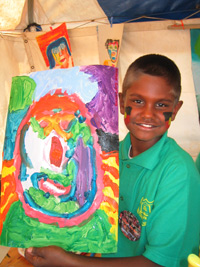
My name is Stephen Bennett and I am a portrait painter. I travel around the world painting portraits of Indigenous people. My mission is to use my portraits to educate others about Indigenous culture. The world's Indigenous peoples live in the most diverse, colorful and fantastic ways. I want to help empower these peoples to continue and preserve their traditional ways of life. What you are about to read are some of my adventures as I attempt to learn more about the Aboriginal people in Australia. This documentary captures parts of my journey that led me to the people who became the subjects in my paintings. These are the people and locations that inspire my work. Let's go down under.
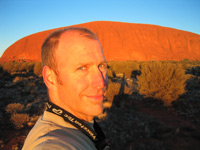 Australia is an island continent and one of the most sparsely populated countries on earth. Only 18 million occupants cling to the rim of a country almost the size of the United States, which has a population of over 270 million. The vastness of Australia has to be experienced in order to be felt and appreciated. It is also one of the driest and flattest continents on the planet. Australia is an island continent and one of the most sparsely populated countries on earth. Only 18 million occupants cling to the rim of a country almost the size of the United States, which has a population of over 270 million. The vastness of Australia has to be experienced in order to be felt and appreciated. It is also one of the driest and flattest continents on the planet.
Australia, however, is a land of great diversity and also contains tropical rainforests, majestic rivers, snow capped mountain ranges, vast grass-lands, and of course the fiery red interior. To those outside Australia, the myths are many: amazing surfing, Bushrangers, boomerang throwers, a Great Barrier Reef and very strange and unusual animals. All in all in 9 months in Australia I covered over 30,000 kilometers and just began to get a feeling for the place.
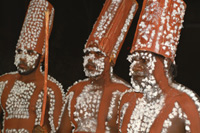 Ever since I can remember, the one thing that really fascinated me about Australia was its Aboriginal people. Before the arrival of the Europeans on the continent, there were between 600 and 700 Aboriginal "nations" or tribes that spoke between 200 and 250 languages. All have customs, rites and beliefs which varied among the different nations. Aboriginals are the oldest continuous culture in the world, having lived on the continent for at least 50,000 years. How had this been possible? What customs and practices could be so enduring? And how had life changed since the invasion of the Europeans roughly 200 years ago? Were Aboriginals still living traditionally or not? I was determined to find out. Ever since I can remember, the one thing that really fascinated me about Australia was its Aboriginal people. Before the arrival of the Europeans on the continent, there were between 600 and 700 Aboriginal "nations" or tribes that spoke between 200 and 250 languages. All have customs, rites and beliefs which varied among the different nations. Aboriginals are the oldest continuous culture in the world, having lived on the continent for at least 50,000 years. How had this been possible? What customs and practices could be so enduring? And how had life changed since the invasion of the Europeans roughly 200 years ago? Were Aboriginals still living traditionally or not? I was determined to find out.
The first British explorers landed near Sydney which was my first stop in Australia. All major Australian cities are on the coast, so the water is never far away. It was across this ocean that Aboriginals would have first spotted the British ships and on this soil that the two cultures clashed. The beautiful coastland where Sydney now stands is sacred land for Aboriginals. Many tribes had fished, hunted and carried out their traditional practices in these locations for thousands of years.
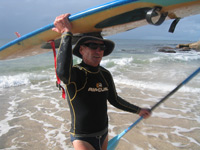 On the wild Sydney beaches the surf can be huge. While I was watching a wild storm unfold off Coogee Beach next to Wedding Cake Island, I noticed some surfers that were making the most of the gigantic waves. I tore myself away from these mad surfers and took a long walk along the jagged cliffs to leave La Perouse. There I met Spike Jones. He pointed out to me the beach where Captain Cook and the first Europeans arrived in Botany Bay. Captain Cook's journals tell us that the first Aboriginals that he saw that were out fishing near his ships completely ignored him as if he was invisible! As it turned out, Spike was actually Australia's king! (The king of rock and roll that is). He is one of Australia's top Elvis impersonators. What a head of hair and boy could he Gyrate! On the wild Sydney beaches the surf can be huge. While I was watching a wild storm unfold off Coogee Beach next to Wedding Cake Island, I noticed some surfers that were making the most of the gigantic waves. I tore myself away from these mad surfers and took a long walk along the jagged cliffs to leave La Perouse. There I met Spike Jones. He pointed out to me the beach where Captain Cook and the first Europeans arrived in Botany Bay. Captain Cook's journals tell us that the first Aboriginals that he saw that were out fishing near his ships completely ignored him as if he was invisible! As it turned out, Spike was actually Australia's king! (The king of rock and roll that is). He is one of Australia's top Elvis impersonators. What a head of hair and boy could he Gyrate!
While exploring Sydney I stumbled across the ANZAC Day parade. ANZAC stands for Australia and New 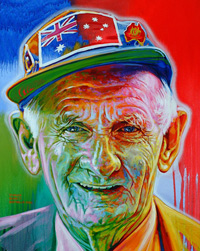 Zealand Army Corp. It commemorates Australia's and New Zealand's involvement in the world wars. Anzac Day marks the defeat of the Australians and New Zealand by the Turks during World War I. ANZAC Day is a day that honors war veterans and for many Australians is a celebration of nationalism and nationhood. I was surprised and disappointed not to find any Aboriginal veterans marching. I later learned that the reason was probably because Aboriginal soldiers missed out on recognition and did not receive the same post war benefits as their white counterparts. So they mostly skip the Parade. Zealand Army Corp. It commemorates Australia's and New Zealand's involvement in the world wars. Anzac Day marks the defeat of the Australians and New Zealand by the Turks during World War I. ANZAC Day is a day that honors war veterans and for many Australians is a celebration of nationalism and nationhood. I was surprised and disappointed not to find any Aboriginal veterans marching. I later learned that the reason was probably because Aboriginal soldiers missed out on recognition and did not receive the same post war benefits as their white counterparts. So they mostly skip the Parade.
I was intent on finding out more about what it is like to be an Indigenous person in Australia. Speaking to a number of prominent Aboriginals gave me more of an understanding of their history and the discrimination they have faced over the years. They helped me understand the state of affairs between whites and blacks, which I later learned are called Whitefellas and Blackfellas.
The Aboriginal race has endured extended persecution and from 1883 to 1969, over 100,000 half-caste indigenous children were forcibly taken from their families and raised by the state. This was a process where the Australian government tried to assimilate the half-caste or half-breed Aboriginals into the white culture. The goal was to accelerate the process of assimilation and to eliminate their culture as it was believed by whites that, through inbreeding, it would be absorbed or die out. This means that if your parents were of a mixed marriage between black and white, you would have been taken away in an effort to assimilate you into white society. There is now a strong push by many Australians for the government to officially apologize to these people. So far they have not.
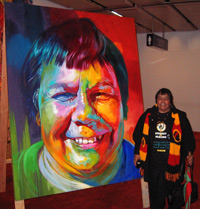 This group of people is now called the Stolen Generation. Valerie Linlow was the first member of the stolen generation to receive financial compensation from the government and one of the strongest people I have ever met. The fact that Valerie does not speak her tribe's language is a sad consequence of her forced removal from her family, who were her link to Aboriginal culture. She, along with all of the other members of the stolen generation is on a journey of healing and rediscovery of their heritage. "Sorry Day" is a new Australian holiday that honors the Stolen Generation. During Sorry Day I painted a portrait of Valerie at the Sydney Opera House to raise awareness of the Stolen Generation. We had a great time together there and her portrait is spectacular. This group of people is now called the Stolen Generation. Valerie Linlow was the first member of the stolen generation to receive financial compensation from the government and one of the strongest people I have ever met. The fact that Valerie does not speak her tribe's language is a sad consequence of her forced removal from her family, who were her link to Aboriginal culture. She, along with all of the other members of the stolen generation is on a journey of healing and rediscovery of their heritage. "Sorry Day" is a new Australian holiday that honors the Stolen Generation. During Sorry Day I painted a portrait of Valerie at the Sydney Opera House to raise awareness of the Stolen Generation. We had a great time together there and her portrait is spectacular.
I also spoke to Aboriginal leader Gatchill Djerrkura (Ja Kurra, phonetic), who shared with me some of his aspirations for the Indigenous people of the future. His mission is to give self-sufficiency to Aboriginal people through education and the development of an Aboriginal business community so that they are no longer dependent on the Australian government. Aboriginals are entitled to an assistance check from the government every two weeks. Even a person able to prove that they are 1/16 Aborigine is entitled to receive this check. Gatchill Djerrkura believes that this assistance is disempowering to his people and that they need to become independent and earn money on their own.
Another leader of the Aboriginal people is Senator Aden Ridgeway. Senator Ridgeway is the only Aboriginal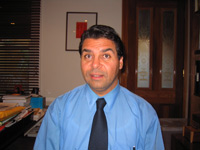 member of the Australian Parliament. He has a dream of reconciling black and white Australians. In my view, he is a bit of an Aboriginal Martin Luther King Jr. He has known he wanted to go into politics since he was 10 years old. He has come a long way since growing up on an Aboriginal reserve in the 1960s, a time when racial segregation was still commonplace. Blacks had to enter the cinema through the back door and never could swim in public swimming pools. Senator Ridgeway told me of how he hopes to help find ways that Aboriginal people and their culture can coexist in Australia with all the others in a harmonious way. member of the Australian Parliament. He has a dream of reconciling black and white Australians. In my view, he is a bit of an Aboriginal Martin Luther King Jr. He has known he wanted to go into politics since he was 10 years old. He has come a long way since growing up on an Aboriginal reserve in the 1960s, a time when racial segregation was still commonplace. Blacks had to enter the cinema through the back door and never could swim in public swimming pools. Senator Ridgeway told me of how he hopes to help find ways that Aboriginal people and their culture can coexist in Australia with all the others in a harmonious way.
The Aboriginal culture is complex and far reaching. It has faced many extreme challenges since the arrival of the Europeans. Such hardships include being dispossessed of their lands, ravaged by new western diseases and subject to massacres, poisonings and genocide. There have been many ways that Indigenous Australians have fought for reconciliation and recognition. The Tribal Warrior is one such example.
Crewed only by Indigenous people, the Tribal Warrior is a sailboat that circumnavigated Australia and whose mission it is to raise awareness of Aboriginal issues. It is also used as a training vessel to help crewmembers become licensed captains. I rode alongside the ship as she triumphantly sailed into Sydney Harbor after a two-year voyage. Its sail is decorated with the red, black and yellow colors of the Aboriginal Flag.
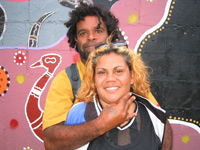 The largest concentration of Aboriginal people in Sydney is the neighborhood of Redfern. I spoke to a local Aboriginal resident about its historical significance. He told me that Redfern was one of the original Aboriginal communities in Sydney before the arrival of the Whites. There, a memorial is dedicated to Pemulwuy, a resistance fighter who fought the British for twelve long years until his death in 1802 and who is suspected to have died near Redfern. Everleigh Street in Redfern is now referred to as "The Block." It is a neglected area of four by four blocks that has a dangerous reputation as a place to buy drugs and where Blackfellas get wild. A campfire burns during most nights, welcoming all those who dare to go into the mania of "the Block". It is an important meeting point visited by Indigenous people from across the continent. It is managed by an Aboriginal council and is technically a miniature Aboriginal reserve. Up until the present day Aboriginal people have struggled to hold on to this piece of land. It is a place filled with many interesting characters, all with unique stories. I was fortunate enough to hangout and make a few friends at the Block. The largest concentration of Aboriginal people in Sydney is the neighborhood of Redfern. I spoke to a local Aboriginal resident about its historical significance. He told me that Redfern was one of the original Aboriginal communities in Sydney before the arrival of the Whites. There, a memorial is dedicated to Pemulwuy, a resistance fighter who fought the British for twelve long years until his death in 1802 and who is suspected to have died near Redfern. Everleigh Street in Redfern is now referred to as "The Block." It is a neglected area of four by four blocks that has a dangerous reputation as a place to buy drugs and where Blackfellas get wild. A campfire burns during most nights, welcoming all those who dare to go into the mania of "the Block". It is an important meeting point visited by Indigenous people from across the continent. It is managed by an Aboriginal council and is technically a miniature Aboriginal reserve. Up until the present day Aboriginal people have struggled to hold on to this piece of land. It is a place filled with many interesting characters, all with unique stories. I was fortunate enough to hangout and make a few friends at the Block.
Most of the places where Indigenous people are still able to live traditionally are in the deserts of Australia's interior and in the Northern regions where the land is too hostile or wild to be farmed or settled. If you want to get out and see these people, you have to be prepared to travel some serious miles, often across very rough country. Everyone in Redfern told me to go to Arnhem Land to see pure bloods or one hundred percent Aboriginals. Arnhem Land is one of the largest Aboriginal reserves in the Northern Territory. Through a couple of lucky connections and generous sponsors, I was on my way. My final destination would be Yirkalla, the land of the Yolgnu people. This was an incredibility-isolated region with little contact with the outside world. It was a 5-hour flight from Sydney to Darwin - the Northern Territory's capital city. From Darwin, it took two days by car to cross Arnhem Land to reach Yirkalla on the coast of the Bay of Carpenteria. We arrived at nighttime - just in time for a traditional celebration of partying and didgeridoo music.
Before or group could enter the little community on Bawaka beach, our host Wessely blessed us. I had chills as he waved a sacred wooden stick over me, speaking soft words to the spirits as I knelt in the sand. The Yirkalla area is the place where, according to Yolugu law, the Didgeridoo came into being. In Yolugu language the didgeridoo is called the Yidaki. While in Yirkalla I met the traditional caretaker of the Yidaki and his name is Djalu Gurruwiwi. He is the most sought after Didgeridoo maker in the world. I spent time with him and his family at their house on Ski Beach. He had a stream of international visitors while I was there and after a bit of wheeling and dealing sold me one of his famous musical works of art. I have since then painted his portrait in all the colors that I recalled from the sunrises and sunsets while camping next to his beach home.
Continue...
|







